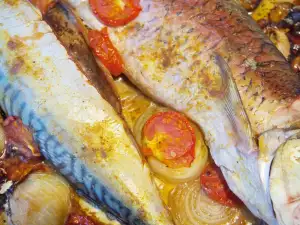Bonito /Atlantic bonito, Sarda sarda/ is a saltwater fish from the Scombridae family and genus /Bonito/, which resembles the mackerel. However, bonito differs from it in its longer first pectoral fin. The upper part of the body of Sarda sarda is painted in a dark gray color.
The belly of the fish is gray, but is relatively lighter than the back. Usually bonito reaches 75 centimeters and sometimes its body length exceeds eighty centimeters. Its average weight is about 3-4 kilograms. Large representatives of the species reach 7 kilograms. The bonito is distinguished by its sharp teeth.
It is a predatory fish that feeds on fish like sprat, anchovy and horse mackerel. It inhabits the waters of the Atlantic Ocean, the Black Sea and the Mediterranean Sea. It can be seen along the coasts of America, Africa and Europe. It is considered a heat-loving fish that spends winters in the Sea of Marmara and in the spring months it returns to the Black Sea /some of the groups remain there in the winter as well/.
Representatives of this species reach sexual maturity, usually in their second year. Of course, although less often, there are also those in which this happens already in the first. These fish spawn from spring to late summer. This is most strongly observed in the month of July.
For this purpose, they choose the coastal area of the Black Sea or some of its northwestern section. During spawning, the water temperature is between 18 and 25°C. The spawn takes about 48 hours to hatch. Small fish feed on plankton and quickly gain weight. Before the beginning of autumn, their body length has already reached more than 40 centimeters. Over time, the fish stop growing in length, after which their weight begins to increase. When it's the season for the bonito to move, the representatives of the species gather in passages and move this way to warmer waters.
History of bonito
Bonito is a preferred seafood not only nowadays. In the ancient era, the population of Apollonia resorted to catching bonito. Together with the mackerel, it helped them to eat. In fact, drying fish was a common practice even then.
Catching bonito

The bonito could hardly be caught on shore. It is caught without bait. If you want to catch this type of fish, you will need to use a boat and also get a bonito hook/fish hooks that are tied in pairs/. Bonito tackles are coarser and stronger, as members of the species will not surrender easily.
Its healthy teeth will try to tear the cord. The other device you can use to catch bonito is a net. You can use bottom nets or floating nets. The former are preferred by fishermen during the summer months and also during the autumn months. Bottom nets are a solution before winter sets in.
Bonito composition
Along with fish such as mackerel, salmon, sardine, herring and others, bonito is classified as oily fish. Bonito contains many beneficial ingredients for the body. It contains vitamin A, vitamin D, vitamin B1, vitamin B2, vitamin B6, vitamin B12. It also contains valuable omega-6 and omega-3 fatty acids.
Benefits of Bonito
Bonito, in addition to being a tasty food, is a source of many useful substances. Eating a bonito has a good effect on the whole organism. Fish is especially good for the brain thanks to the omega-3 fatty acids that are hidden in its composition. Regular intake of bonito strengthens the activity of the brain and supports the thought process. On the other hand, fish is also good for the heart. Studies show that eating it helps reduce depression.
Selection and storage of bonito
Bonito can be stored by drying them beforehand. For this purpose, you need to choose fresh fish, the skin of which is free of damage. The belly of the fish should not be bulging. The fish suitable for culinary use has a transparent cornea and its body is elastic. It should not have a bad smell. The entrails are removed from the fish and they are washed and salted.
If desired, other spices such as black pepper, paprika and cumin are added. After that, the fish are placed in a container with a lid, which should be left in the refrigerator for 7-8 hours, until the meat absorbs the spices. They are strained from the water separated in the container and hung in a ventilated place with a temperature of 30-35°C. Dried fish can be kept in the freezer.
Cooking bonito

Bonito is among the favorite fish of seafood lovers. This species can be eaten pickled, grilled, dried, marinated or fried. It is present in a number of fine specialties. Among the classic bonito dishes are:
This type of fish can also participate in salads and soups and fish stews. It is successfully combined with onions, olives, boiled potatoes, tomatoes and various sauces. You can't go wrong if you season the fish with spices like black pepper, lovage, basil, bay leaf, curry, dill and thyme.
With lemon juice and white wine, you can also make bonito even more appetizing.
When preparing bonito certain rules must be followed - remove the gills and guts. Don't forget to remove the reddish stripe along the spine as well. In different dishes bonito is cut into different sized pieces or slices. It is permissible to freeze it.














Comments